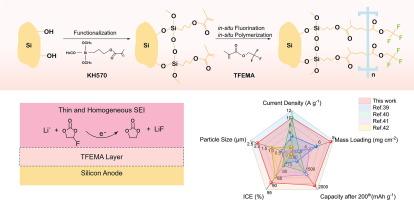Integrating robust SEI on recycled micro-sized silicon scrap for stable lithium ion battery
IF 13.3
1区 工程技术
Q1 ENGINEERING, CHEMICAL
引用次数: 0
Abstract
Silicon (Si) based anode materials for lithium ion (Li+) batteries have garnered significant attention due to their high specific capacity, low lithium insertion potential, but higher cost than usual graphite anode. The generation of Si scrap from the slicing of photovoltaic Si leads to substantial material scrap. Here, we present a novel technique that an organic molecular encapsulation with elastic polymer silane coupling agent (KH570) crosslinking with trifluoromethyl ethyl methacrylate (TFEMA) on the surface of micrometer-scale photovoltaic Si scrap particles via hydrolysis followed by polymerization. The fluorination termination functional groups would induce a more stable LiF-rich solid electrolyte interface (SEI) during the cycling, which lead to the reduction in Li+ and charge transfer resistance. More importantly, the crosslinking network of the elastic polymer, enables micrometer-sized Si scrap maintain the capacity retention of at 5 A/g for 500 cycles (985mAh/g, 5 times than pure Si scrap) and achieves a 90 % retention rate after 100 cycles (131mAh/g) in a full cell system. Furthermore, the Si scraps with such a functional organic coating could be matching with a polymer-based electrolyte as an all-solid battery, which present a specific capacity of 1000mAh/g. This technique of organic molecular encapsulation is straightforward, replicable and holds considerable practical value for the recycling of resources.

求助全文
约1分钟内获得全文
求助全文
来源期刊

Chemical Engineering Journal
工程技术-工程:化工
CiteScore
21.70
自引率
9.30%
发文量
6781
审稿时长
2.4 months
期刊介绍:
The Chemical Engineering Journal is an international research journal that invites contributions of original and novel fundamental research. It aims to provide an international platform for presenting original fundamental research, interpretative reviews, and discussions on new developments in chemical engineering. The journal welcomes papers that describe novel theory and its practical application, as well as those that demonstrate the transfer of techniques from other disciplines. It also welcomes reports on carefully conducted experimental work that is soundly interpreted. The main focus of the journal is on original and rigorous research results that have broad significance. The Catalysis section within the Chemical Engineering Journal focuses specifically on Experimental and Theoretical studies in the fields of heterogeneous catalysis, molecular catalysis, and biocatalysis. These studies have industrial impact on various sectors such as chemicals, energy, materials, foods, healthcare, and environmental protection.
 求助内容:
求助内容: 应助结果提醒方式:
应助结果提醒方式:


